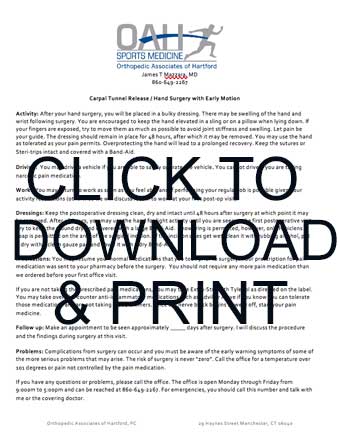Activity: After your arthroscopic lysis of adhesions and manipulation, you will be placed in an arm sling. When the nerve block wears off, you may remove the sling and begin to use the arm as tolerated. Use it as normally as possible but avoid heavier and more difficult tasks until you are seen in the office.
You may use your hand and bend your elbow and fingers as much as you can tolerate right after surgery.
If you had surgery at the surgery center, you will likely have a cooling cuff. Use it as directed as much as possible. It helps control swelling and pain. If you do not have a cooling cuff, apply ice packs to the shoulder for 20-30 minutes at a time as often as you need to control pain. Do not apply ice directly to the shoulder. Cover the shoulder with a towel then apply the ice packs.
Dressings: The post op dressing should remain in place for 24 hours after surgery. It is normal to have drainage on the dressing after surgery. If this lasts more than 24 hours, call the office or go to one of our Orthopedic Associates of Hartford Urgent Care Centers to have it checked.
After 24 hours, you may remove the operative dressing yourself and shower. It is OK to get the incisions wet in a shower after the first 24 hours but do not soak them in bath water for one week. Only Hibiclens soap may be used on the surgical site. After a shower, clean the incisions with alcohol and cover with a Band-Aid.
You may wear the arm sling for comfort if you feel that you must, but you are encouraged to not wear it and move the arm as if it were normal. Try to avoid activities that cause pain that exceeds 5 out of 10. (10/10 is the worst pain)
Driving: You may not drive while wearing a sling. If you are out of the sling and not taking narcotic pain medications, you may drive only if you feel safe doing so and can move the shoulder enough to control the vehicle in routine and emergency circumstances.
Work: You may return to work as soon as you feel able and performing your regular job is possible given your activity restrictions.
Medications: You may resume your normal medications that you took prior to surgery. Your prescription for pain medication was sent to your pharmacy before the surgery. You should not require any more pain medication than we ordered before your first office visit.
If you are not taking the prescribed pain medications, you may take Extra-Strength Tylenol as directed on the label (up to 1000mg every 6 hours). If you know you can tolerate and have no reason to avoid taking naproxen (Aleve) and ibuprofen (Advil), you can take nonsteroidal anti-inflammatory medications in addition to the Tylenol and prescribed pain medications. Once the nerve block begins to wear off, start your pain medicine.
The maximum dose of Aleve (naproxen, 220mg) is 2 tablets twice per day with food. The maximum dose of Advil (ibuprofen, 200mg) is 4 tablets three times per day.
Unless you are allergic, take one aspirin 81mg twice per day to reduce the chances of blood clots. Blood clots may occur after any surgery or injury to the leg and may be associated with complaints of calf pain, calf cramping, pain in back of the knee, chest pain or shortness of breath.
Follow up: Make an appointment to be seen on the first office day after surgery. I will discuss the procedure and the findings during surgery at this visit.
Problems: Complications from knee surgery can occur and you must be aware of the early warning symptoms of some of the more serious problems that may arise. The risk of surgery is never “zero”.
Call the office for a temperature over 101 degrees, pain not controlled by the pain medication, or drainage from the incision that lasts more than 24 hours or calf pain, chest pain, or shortness of breath.
